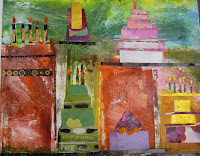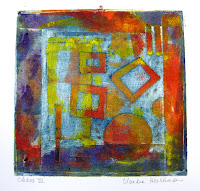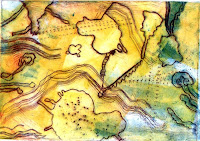 Etsy: claudiahershman.etsy.com
Etsy: claudiahershman.etsy.comUtrecht Artists
Birmingham Society of Women Painters
Blog: claudiahershman.blogspot.com
Brief Bio:
Born and raised in Detroit, Michigan. Attended the University of Michigan, majoring in painting and ceramics. Graduated with a Degree in Design and a teaching certificate. I taught elementary art for 2 years before starting a family. I have taken post graduate classes at The College for Creative Studies in Detroit and the Birmingham Bloomfield Art Center. Art, in one form or another, has always been a part of my adult life.

How did you get started in printmaking?
Serendipity!!! I have only been printmaking for a few years. I had done pottery, painting and worked in Polyform clay, making jewelry. I was away from art for several years while working in advertising sales. I read Drawing on the Right Side of the Brain and it stimulated me and challenged me to see if I could hone my drawing skills. I signed up for a class because I thought that being confident in drawing was the most important first step in working in any medium. I drew in charcoal and pastels for a couple of years and began to feel that my eye was getting sharper and I was getting more confident. To me, the most important part of making art, is training your eye to really “see” what is before you. I went to a class on photo transfer, and thought I might be able to draw and color on my transfers after I printed them. That led to a printmaking class, to learn how to print. The first thing we did was collagraph prints, and I fell in LOVE! They were so much fun, spontaneous, and exciting. A couple of years after I started making prints, as I looked around at the art work that I’ve collected, I realized that I had always been drawn to this medium, and most of the artwork I own is etchings or screen prints!

Describe where you work.
I have a home studio in my basement. I added lighting that simulates daylight, and it’s a cozy and warm space to work in. I have music and a TV for company and I share the space with my grandkids when they come over. My goal is to pass on my love of art to them. I am fortunate to have a good friend who is a genius at making anything, and he made me a wonderful big work table. In addition, he built an extension to a flat file that doubles as an inking surface. Another printmaker friend told me about a press for sale on line, and I was lucky to get an old Japanese school press for a very good price. I also formed a group of 7 other artists and printmakers, and we meet once a week. Working together stimulates us all, and allows for the sharing of ideas, techniques and lunch! In addition, I continue to take classes at a local art school, to connect with printmakers and continue to grow.

What's your favourite printmaking process?
I love making collagraph plates and dry point etchings. Plates can be made from a variety of materials, like the tops of Styrofoam food containers and matt board. I also use industrial plastic for the dry point plates. I like the idea that the same plate can look totally different by the way it’s inked. Also, some of the printmaking processes allow you to work in a painterly way, which combines my love of painting and line.

What's your creative process for any given print? (eg. sketch first? Pre-planned or free-form?)
I am more into free-form. I think about a broad concept and then try to abstract it. I like to let the work lead me. I also like to rework pieces that I think were not successful. Sometimes my best work comes from a piece that didn’t work the first time. I find there is less pressure when working with a piece that is not too precious. I also discovered that I am most comfortable working in a small format. Most of my prints are smaller than 8x10”. I have done images for mini print competitions that are as small as 1x4”. It’s challenging to make an image that is interesting in a small size. In today’s economy, the small size also makes the work more affordable. I also spend a lot of time looking at images that provide a jumping-off point for me. I have moved away from trying to reproduce an image of something, into a more abstract, whimsical way of working.

What do you enjoy most about printmaking?
What I like most is that there are a lot of techniques to choose from. The process also has many steps, and that variety keeps me from getting bored. Each step of making a print is exciting and absorbing. When you get tired one process, you can try another. I find that inking the plate is a real challenge, and makes a huge difference as to how the final print looks. Sometimes I like to just work with a brayer and different colors in a spontaneous way, making a lot of prints quickly. (It keeps me from getting too enmeshed in details.) Some of the prints don’t work, but sometimes there are wonderful, surprising results. These are unique prints that you can’t duplicate. Printmaking reminds me of the excitement you feel when you open a kiln after firing a load of pottery... the magic of the unexpected!
What's your least favorite part of the process?
Cleaning up oil based inks! I solved that problem, and the problem of the toxicity of the solvents, by working with water miscible oil paints. I also don’t like doing large editions of the same plate, inked the same way, in the same colors. I am most excited by spontaneous accidents.

What are your inspirations (other artists, people, places, events, etc.)?
I love the work of Hundterwasser, Paul Klee, William Kentridge and Richard Jerzy. I love COLOR and am very attracted to it and affected by it. I look at work on the internet, go to galleries and art fairs. Looking is inspiration. The smallest detail can be a jumping off point for a print.

How has your work changed and evolved since you started?
My work has grown from dependence on concrete visuals to experimentation with color, line, and shape. Printmaking has helped me to work looser and more spontaneously. Because of the move away from concrete images, my work has taken on a more abstract, mysterious quality. As I learn new techniques, my options increase for each print. When I was painting and drawing, I was more tied to the image.
How do you get past creative slumps?
I read, look at other art, talk to artists and just start working on something to see where it will lead. I try to start with a vague idea of a theme and go from there. I look at how children work and take inspiration from their total faith in what they produce and how they break all the rules we learned in art school. I also collect pictures of work I like to refer to when I am in a slump.

How do you promote your work?
I am on Etsy, a member of Printsy, I enter local shows and competitions, talk about it to other people and email new images to my mailing list. I send thank you notes to buyers with images of my work, and invite them to view my work online too. I put a variety of images of my prints on my business cards to remind people of what my work looks like.
Any other comments or advice for others who want to try making hand-pulled prints?
Try it! It’s fun, versatile, interesting, varied, and there are so many possibilities. You don’t have to be dependent on drawing to make an interesting print. There are great classes in many local art schools or community colleges. The world is your oyster in this medium. (Can you tell that I love it?)
1 comment:
I just featured Claudia on my blog this week-end!
Beautiful work...
Post a Comment